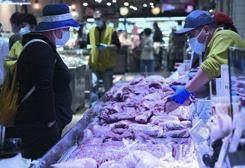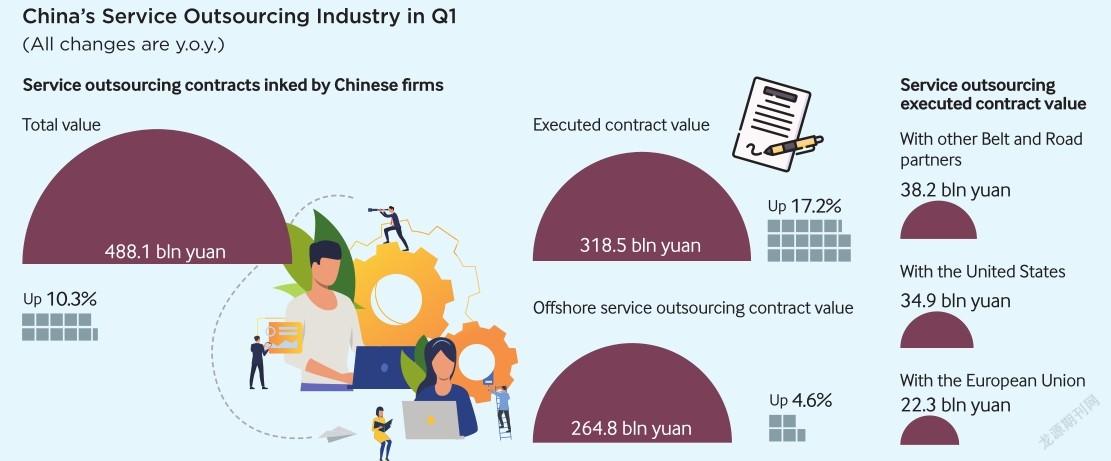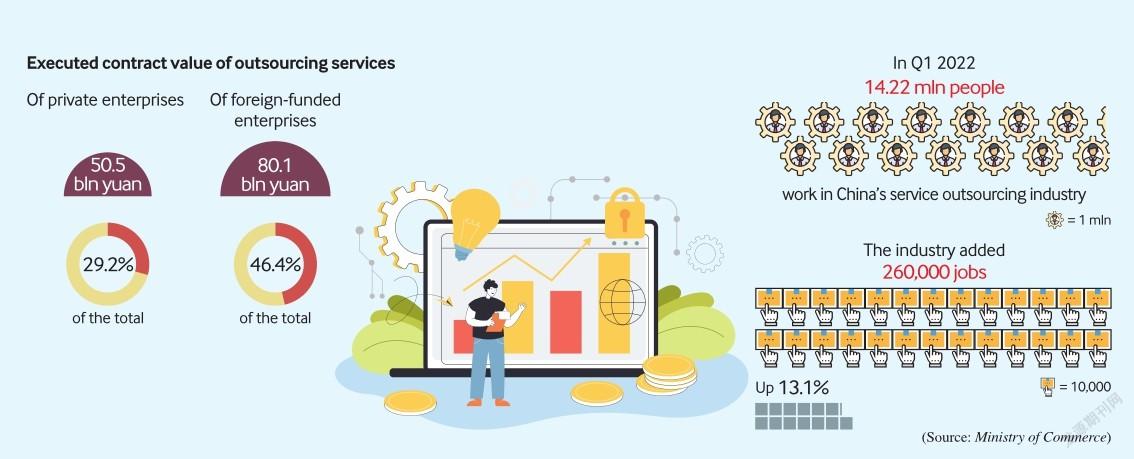THE WINTER OLYMPIC EXPERIENCE

The National Sliding Center for bobsled, luge and skeleton and the Winter Olympic Village in Beijings Yanqing District on April 26. Venues of the Olympic Winter Games Beijing 2022 and the Olympic Village opened to public on April 29. People can now visit the National Alpine Skiing Center and National Sliding Center in the capitals northern suburb, treat themselves to an Olympic dish or two and try out the villages accommodations.
Homecoming
Chinas research icebreaker Xuelong arrives in Shanghai on April 26, marking the end of the countrys 38th Antarctic expedition. Two icebreakers participated in the 174-day Antarctic expedition, with the Xuelong 2 arriving in Shanghai six days ago. The scientific venture involved a range of tasks, including the replenishment of materials and staff rotation at Chinas Zhongshan and Great Wall stations in the region, as well as marine observations and oceanic ecosystem investigations.

Safety Standards
The Ministry of Housing and Urban-Rural Development has unveiled a new set of standards to avoid major hidden dangers in the construction of urban housing projects. The standards aim to ensure workplace safety and prevent major accidents, Xinhua News Agency reported on April 26.
Hidden dangers in the housing sector include problems that may cause death, injury or major economic loss during the construction process, according to the ministry.
Enterprises and individuals undertaking unlicensed construction should be considered major risks.
In recent years, Chinas work safety in the construction sector has been generally stable, with fewer major accidents reported, an official with the ministry said. However, the official warned that the total number of accidents still remains relatively high, and the risk of major accidents has not yet been eradicated.
The ministry called on relative departments to focus on the safety inspections of large projects and high-risk operations, to eliminate major hidden dangers and ensure construction site risks are controllable.
New Vaccine
A Chinese-made inactivated vaccine against the Omicron variant of the novel coronavirus was approved for clinical trials by the National Medical Products Administration on April 26.ABB2DB35-3266-40BC-99BC-312E854A69DA
The vaccine, developed by the China National Biotec Group affiliated with Sinopharm, has been under research since December 2021, the company said.
Preliminary tests, for safety and efficacy, showed that the vaccine can produce antibodies that are highly effective against various variants including Omicron, it said.
In the clinical trials, a randomized, double-blind and cohort study method will be adopted, studying people aged 18 and above who have received two or three doses of other COVID-19 vaccines.
Highway Network
The total length of Chinas highway network has reached 5.28 million km, an official said on April 26.
Zhou Rongfeng, an official with the Ministry of Transport, underscored the importance of strengthening highway maintenance and management as highways are among the most widely used means of transportation, with the most extensive coverage and the largest number of passengers.
A total of 1.29 trillion yuan($196.7 billion) has been channeled into highway maintenance and addressing highway safety hazards in recent years, according to the ministry.
According to Zhou, the country will continue to increase its highway maintenance and management over the 14th FiveYear Plan (2021-25) period.
Efforts will be made to renovate old bridges and tunnels, accelerate the construction of battery charging and swapping stations, and improve electronic toll collection services, Zhou said.
Yellow River Protection
The State Council has announced it will support Ningxia Hui Autonomous Region in developing a pilot zone for the ecological protection and high-quality development of the Yellow River basin, Xinhua reported on April 26.
The statement urged efforts to take water into account when managing the city, land, people and production, while unswervingly following the path of green and low-carbon development.
Hard work is required to address environmental problems, conserve and control water, and protect and restore ecosystems, with solid progress made in Yellow River protection, according to the statement.
Last year, Chinese authorities issued a plan to improve the conservation and utilization of water resources in the Yellow River basin as part of the countrys efforts to advance ecological protection and the regions highquality development.
By 2025, water consumption per 10,000 yuan ($1,570) of GDP in the Yellow River basin should be capped below 47 cubic meters, down 16 percent from the 2020 level, according to the plan.ABB2DB35-3266-40BC-99BC-312E854A69DA
Budding Bibliophiles
Parents and children immersed in reading at a bookstore on World Book Day in Xiamen, Fujian Province, on April 23.

Sewage Treatment
Sewage treatment in rural areas will be improved and the rural domestic sewage treatment rate will reach 40 percent in 2025, up from 28 percent in 2020, the Ministry of Ecology and Environment said on April 22.
Government organizations, market entities and villagers will be encouraged to join hands to achieve this goal, the ministry said.
Rural sewage treatment has faced the challenges of high costs, long investment return cycles and a lack of maintenance staff.
The move is part of Chinas efforts to push forward rural revitalization.
Tourism Vouchers
The Yunnan Provincial Bureau of Culture and Tourism began handing out vouchers worth a total of 300 million yuan ($45.7 million) on April 25, with the aim of boosting tourism within the province.
The vouchers, consisting of 200 million yuan ($30.5 million) for the consumption of tourism products and services, and 100 million yuan ($15.2 million) for consumption at gas stations, will be handed out in several rounds throughout the year to residents of Yunnan and neighboring provinces.
A representative of the bureau said the move aims not only to stimulate cultural and tourism consumption, but also to lift market confidence.
Kindergarten Growth
The number of kindergartens in China reached 295,000 in 2021, up nearly 77 percent from a decade ago, according to the Ministry of Education on April 26.
Of all the new kindergartens established in the period, around 60 percent are located in rural areas. By 2021, the country boasted 245,000 governmentfunded and privately-run non-profit kindergartens, representing 83 percent of all kindergartens nationwide.
The figures also showed that the gross preschool enrollment ratio rose to about 88 percent in 2021 from 62.3 percent in 2011.
The preschool education workforce in the country is also experiencing strong growth. According to the ministry, in 2021, Chinas number of kindergarten principals and professional teachers reached over 3.5 million, 2 million more than in 2011.
Sufficient Supplies
A shopper selects meat at a supermarket in Haidian District, Beijing, on April 26. Agricultural product wholesale markets, supermarkets and logistics companies in Beijing have taken measures to ensure the supply of daily necessities for residents following a recent COVID-19 resurgence in several of the citys districts.ABB2DB35-3266-40BC-99BC-312E854A69DA

Consumption Boost
The General Office of the State Council on April 25 unveiled guidelines to further tap into the countrys consumption potential.
As part of measures to tackle short-term bottlenecks, large and medium-sized cities will build warehouses in their suburban areas to ensure the supply of daily necessities in case of emergencies.
Financial institutions are required to provide more support to the real economy through policies such as lowering interest rates and cutting fees.
To boost consumption in the medium and long term, the country will develop products and services that cater to the needs of the elderly and infants, while encouraging innovations in cultural consumption.
Further efforts will tap into the potential of the vast rural areas, promoting the sales of automobiles and home appliances there.
In addition, restrictions on vehicle sales in urban areas are called to be phased out.
The government also plans to establish several duty-free shops within the cities and improve related policies to develop pro-consumption platforms.
Consumption is a primary engine for economic growth in China. In the first quarter of 2022, final consumption contributed 69.4 percent to GDP expansion, which came in at 4.8 percent year on year.
Canton Fair
The number of overseas purchasers registered for the justconcluded 131st Session of the China Import and Export Fair, also known as the Canton Fair, hit a record high of 536,000, coming from 228 countries and regions.
Running from April 15 to 24, this edition took place online due to COVID-19 restrictions.
The number of registered overseas buyers increased by 48 percent compared with the 129th session and 41.8 percent from the 130th session, according to Xu Bing, spokesperson for the fair.
Among them, 298,100 were from other Belt and Road Initiative participants, accounting for more than 55 percent of the total, while 150,800 came from members of the Regional Comprehensive Economic Partnership, constituting over 28 percent, Xu said.
Over 3 million exhibits were displayed online, including 951,500 new products, both new records for the fair. The online exhibition hall received over 6.2 million visits over 10 days. Exhibitors issued a total of 210,500 electronic business cards, and overseas buyers participated in about 100,000 online conversations.ABB2DB35-3266-40BC-99BC-312E854A69DA
Since 1957, the fair has taken place twice a year in Guangzhou, Guangdong Province, to facilitate global trade. It took place online and offline for the first time in autumn last year.
Forex RRR Cut
The Peoples Bank of China, the central bank, announced on April 25 that it will cut the reserve requirement ratio (RRR) for foreign currency deposits from the current 9 percent to 8 percent, starting from May 15.
The move aims to strengthen the management of foreign currencies in financial institutions, the bank said in an online statement.
Invention Patents
China has authorized over 2.53 million patents for inventions over the past five years, with an average annual growth rate of 13.4 percent, according to the China National Intellectual Property Administration on April 24.
Some 27.7 million trademarks were registered in the same period, with an average annual increase of 29 percent,Shen Changyu, head of the administration, announced at a press conference.
In 2021, the country authorized 696,000 invention patents, with average ownership of highvalue invention patents reaching 7.5 per 10,000 people, nearly twice that at the end of 2017, Shen said.
He added China had also witnessed significant improvement in the efficiency of the use of intellectual property rights (IPRs). The added value of patent-intensive industries reached 12.13 trillion yuan ($1.88 trillion) in 2020, up 5.8 percent year on year, accounting for 11.97 percent of the countrys GDP.
The added value of patentintensive industries should account for 13 percent of GDP by 2025, according to Chinas 2021-35 plan for IPR development.
In 2021, Chinese companies filed 8,596 patent applications in other Belt and Road Initiative participating countries, a year- on-year increase of 29.4 percent; these countries in turn applied for 25,000 invention patents in China, Shen said.
Telecom Growth
The combined revenue of the telecommunications sector rose 9.3 percent year on year to 393.5 billion yuan ($60.9 billion) in the first quarter of 2022, a pace 2.8 percentage points faster than during the same period last year, according to the Ministry of Industry and Information Technology.
Emerging industries, such as big data, cloud computing, Internet data centers and the Internet of Things (IoT), registered rapid expansion. The emerging business revenue of the three telecom giants—China Telecom, China Mobile and China Unicom, surged 36.3 percent year on year to 79.7 billion yuan ($12.1 billion) during the period.ABB2DB35-3266-40BC-99BC-312E854A69DA
In breakdown, the revenue for cloud computing services soared 138.1 percent year on year, while that for big data and the IoT surged 59.1 percent and 23.9 percent, respectively.
By late March, China had 1.56 million 5G base stations, with 134,000 built in the first three months of the year.
Renewable Energy
In the January-March period, Chinas wind power capacity jumped 17.4 percent year on year to 340 million kW, while solar farms saw capacity reach 320 million kW, an increase of 22.9 percent, according to the National Energy Administration.
By the end of March, the countrys total installed power generation capacity was approximately 2.4 billion kW, up 7.8 percent from a year ago, the data showed.
China has announced it will strive to peak carbon dioxide emissions before 2030 and achieve carbon neutrality before 2060.
The country is forging ahead in renewable energy development to improve its energy structure.
According to an action plan released last year, it aims to increase the share of non-fossil fuels in primary energy consumption to around 25 percent by 2030.
ODI on Rise
Chinas non-financial outbound direct investment (ODI) reached 170.95 billion yuan ($26.1 billion) in the first three months of the year, up 6.3 percent year on year, official data showed on April 21.
In U.S. dollar terms, it rose 8.5 percent from a year ago, according to the Ministry of Commerce.
Other countries participating in the Belt and Road Initiative accounted for $5.26 billion of the sum, an increase of 19 percent year on year.
The ODI into wholesale and retail surged 36.3 percent from a year earlier to $5.45 billion, while investment in the manufacturing sector increased 13.3 percent, the ministry said.
NUMBERS
($1=6.56 yuan as of April 28)



